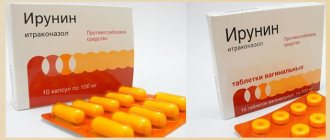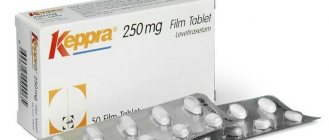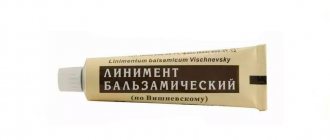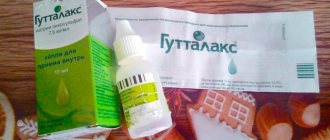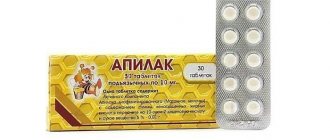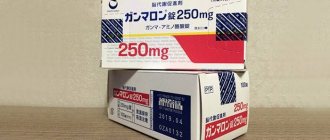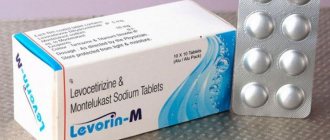Instructions for use of Clindamycin
In the treatment of infectious diseases, the use of highly targeted antibiotics is justified, since over time pathogenic microorganisms develop resistance to broad-spectrum antiviral drugs. Clindamycin is a semisynthetic lincosamine antibiotic used to treat infections caused by anaerobic bacteria. This drug is a derivative of Lincomycin, but has more advanced pharmacological characteristics.
Composition and release form
Clindamycin is available in various forms, which contributes to its wide therapeutic use. The drug is packaged in cardboard boxes with:
- Capsules of 8 pieces in a blister. The package contains 2 blisters.
- A solution for intramuscular and intravenous administration. Ampoules are packaged in 5 pieces in two cell stands.
- Granules for making syrup - in a glass bottle.
- Vaginal cream – in an aluminum tube with 7 disposable applicators.
- Vaginal suppositories - 3 suppositories.
- Gel for external use – in an aluminum tube.
This antibiotic is developed on the basis of Lincomycin - one of its hydroxyl groups is replaced by chlorine. The instructions indicate the following composition of the medicine:
| Release form | Content Description | For what age group of patients? | Volume of substance in the form (ml)/(g) | Active ingredient (mg) | Auxiliary components |
| Gelatin capsule | white powder | children adults | clindamycin hydrochloride: 75, 150 and 300 | talc, lactose monohydrate, corn starch, magnesium stearate | |
| Ampoule | 15% colorless solution | 2 ml 4 ml 6 ml | clindamycin phosphate: 300, 600, 900 | benzene alcohol, water, disodium edetate | |
| Granule | flavored powder | children | 80 ml | 75 mg clindamycin palmitate hydrochloride per 5 ml | |
| Tub | 2% vaginal cream | adults | 20 g 40 g | 20 mg of clindamycin phosphate per 1 g of cream | sodium benzoate, castor oil, propylene glycol, emulsifier EM 3398, macrogol (polyethylene oxide 1500) |
| Candle | vaginal | adults | 2 g | 10 mg clindamycin phosphate per 1 g suppository | solid fat, monoglycerides |
| Tuba | gel | adults children | 15g | 10 mg clindamycin phosphate per 1 g gel | water, carbomer, sodium hydroxide, allantoin, methylparaben, propylene glycol. |
pharmachologic effect
The antibiotic Clindamycin is active against pneumocystis, toxoplasma, and anaerobic bacteria, except for strains resistant to antibiotics of the linciside group. It is characterized by a high degree of penetration of the drug into the area affected by the infection, regardless of the time the patient took the drug. Indispensable in cases of intolerance to penicillin in patients. Can be used in combination with other drugs that fight gram-negative bacteria.
This antibiotic is widely used for the treatment of infections of soft and bone tissues, joints, and respiratory tracts affected by the following pathogenic bacteria:
| Name | Latin name | Characteristics of microorganisms | Diseases caused by these bacteria |
| Staphylococcus | Staphylococcus | gram-positive aerobic | skin infections, endocarditis, osteomyelitis, pneumonia |
| Pneumococcus | Streptococcus pneumoniae | gram-positive anaerobic | community-acquired pneumonia, otitis media, acute sinusitis, rhinitis, laryngitis, bronchitis, meningitis |
| Corynebacteria | Corynebacterium diphtheriae | gram-positive, non-motile rods | diphtheria |
| Mycoplasma | Mycoplasma | anaerobes | urethritis, vaginitis, adnexitis |
| Chlamydia trachomatis | Chlamydia trachomatis | gram-negative nonmotile coccobacilli | urogenital chlamydia |
| Clostridia | Сlostridium perfringens Clostridium tetani | gram-positive, non-motile anaerobic | food poisoning, necrotic enteritis, gas gangrene |
| Bacteroides phrigalis | Bacteroides fragilis | gram-negative anaerobic, nonmotile, capsule-forming | peritonitis, abscesses, endometritis, Reiter's disease |
| Bacteroides melaningenicus | Bacteroides melaningenicus | purulent-septic processes |
Pharmacodynamics and pharmacokinetics
Clindamycin penetrates well into all liquid media, soft tissues of the body and bones. The drug inhibits protein synthesis in the cells of pathogenic microorganisms, exhibiting a bacteriostatic and bactericidal effect. There are a number of bacteria that are resistant to this antibiotic:
| Name | Latin name | Characteristics of microorganisms | Diseases caused by these bacteria |
| Gonococcus Neissera | Neisseria gonorrhoeae | gram-negative diplococci | gonorrheal vulvovaginitis |
| Candida albicans | Candida albicans | saprophytic yeast fungi | candidiasis |
| Vaginal Trichomonas | Trichomonas vaginalis | single-celled flagellated bacterium | urogenital trichomoniasis |
| Enterococcus | Enterococcus | gram-positive anaerobic | meningitis, bacteremia, dysbacteriosis |
| Clostridia | Clostridium tertium Clostridium sporogenes | gram-positive spore-bearing | botulism, tetanus, gas gangrene, clostridial food infection |
| Herpes simplex | Herpes simplex | virus | herpes |
The maximum concentration of the medicinal substance in the blood after oral administration is observed faster than with intramuscular administration. The active substance enters the blood 1-3 hours after taking (administration) the medicine. Having reached the infected area, it remains in the body for about 12 hours, while almost 90% of the substance binds to the proteins of pathogenic microorganisms. Clinical studies have not revealed the accumulation of active substances of the drug. Processed by the liver. Metabolites are completely eliminated after 4 days in urine, bile and feces.
Indications for use
Clindamycin is used to treat infectious diseases caused by pathogenic microorganisms sensitive to the active substance of the drug:
- abdominal cavity and intestines (abscess, peritonitis);
- oral cavity (periodontal abscess);
- urogenital area (bacterial vaginosis, chlamydia, vaginal dysbacteriosis, vaginal candidiasis, endometritis);
- infections of the throat, ear, nose, upper and lower respiratory tract (otitis, tonsillitis, pharyngitis, sinusitis, pleural empyema, diphtheria, scarlet fever, pneumonia, etc.);
- skin and soft tissues (felon, boil, impetiglo, erysipelas, infected wounds);
- infections of joints and bones (septic arthritis, osteomyelitis);
- tropical malaria;
- infectious inflammation of the inner lining of the heart (endocarditis);
- anaerobic septicemia (blood poisoning).
Purpose
The spectrum of action of the antibiotic is similar to lincomycin.
Clindamycin - indications:
- diseases of infectious origin. These are diseases of the ENT organs and respiratory tract;
- diphtheria, scarlet fever, osteomyelitis;
- bacterial endocarditis, septicemia;
- infectious diseases of the genital area, soft tissues;
- skin diseases;
- infections of the abdominal cavity and mouth.
It can also be used as prophylaxis for various injuries, intra-abdominal abscesses, peritonitis, and vaginosis.
Directions for use and dosage
Antibiotic treatment is strictly under medical supervision. The choice of the form of the drug, its dosage and time of administration depend on:
- patient's age;
- his well-being;
- areas of infection in the body;
- severity of the disease;
- sensitivity of the pathogen to the active substance of the drug.
Cream
For vaginal infections, an antibiotic is prescribed in the form of a cream for intravaginal use. A disposable measuring applicator (included in the package) is placed on the tube of cream and filled. To do this, press on the tube without pulling back the applicator piston. One dose of medication (5 mg) is administered into the vagina once a day before bedtime. Duration of treatment – 7 days.
Solution
For adults, a solution for intramuscular (intravenous) injection is used 2 times a day, 300 mg. In case of severe disease, it is possible to increase the daily dose of the drug to 2700 mg. It is divided into 3-4 injections. In this case, a single administration should not exceed 600 mg. Children over 3 years of age are prescribed 15-25 mg per 1 kg of weight and divided into equal parts into 3-4 injections. For severe infections, the dosage for children is increased to 40 mg per day.
For intravenous use, the medicine is diluted with a solution of 0.9% sodium chloride or 5% dextrose to a concentration of no more than 6 mg/ml. The resulting solution is administered dropwise over 10 to 60 minutes (depending on the dose). The maximum permissible dose for a single intravenous injection is 1.2 g. If an 8-hour break is observed between droppers, patients with renal (liver) failure are prescribed the usual dosage of this antibiotic.
Capsules
Children under 12 years of age are not prescribed antibiotics in capsule form. The dosage for patients of other age groups is as follows:
| Age (years) | Number of appointments per day | Average severity of the disease, number of capsules (pcs.) | Severe course of the disease, number of capsules (pcs.) |
| Over 15 | 4 | 1 | 2-3 |
| 12 — 15 | 3 | 1 | 2-3 |
| 8-15 | 4 | 1 | 1 |
Candles
Clindamycin suppositories are used for treatment once a day before bedtime. In a lying position, it is necessary to guide the suppository deep into the vagina. Course – 3-7 days.
Gel
Inflammatory processes on the skin due to bacterial infections are accompanied by a rash in the form of acne. For skin diseases, the doctor may prescribe capsules and gel containing an antibiotic for simultaneous treatment. Gel-like ointment with clindamycin is used for external use. The gel is applied in a thin layer to acne and areas with urgative rash after cleansing the skin.
Cream
Clindamycin vaginal cream is used in gynecology for the treatment of vaginosis. The main component of the product is clindamycin phosphate. The ointment is yellow-cream in color with a slightly distinct specific odor.
Available in tubes of 20 g and 40 g. Use before bedtime, no more than 7 days in a row.
Contraindications and side effects
After use, problems with the urinary system in the form of candidiasis or irritation are possible. Rare cases of bleeding, endometriosis or dysuria.
Common side effects:
- fungal diseases;
- bacterial infections;
- backache;
- deviations in test results;
- allergic reactions.
Problems with the gastrointestinal tract in the form of diarrhea and nausea may also appear. Some patients experience dizziness or itchy skin rashes.
Side effects occur in no more than 10% of patients.
The instructions for Clindamycin cream contain only one contraindication - hypersensitivity to the active substance or lincomycin.
Overdose
Such cases are unknown, but it is important to remember that the drug is used intravaginally only.
Drug interactions
To date, no incompatibility of Clindamycin with other drugs has been observed.
special instructions
Before using Clindamycin cream, you need to undergo a number of studies. This will eliminate the presence of microorganisms that the drug cannot cope with: Clindamycin can cause increased growth of microorganisms, most often yeast-like fungi.
It has not been established that the antibiotic affects concentration, so it is not a reason to refuse to drive a car.
While undergoing treatment, you should not have intimate contact, use tampons or douche.
special instructions
Antibacterial drugs disrupt the normal intestinal flora. Pseudomembranous colitis can develop during the use of this antibiotic and 3 weeks after the course. It is necessary to treat diarrhea and other dangerous symptoms during this period as a manifestation of this diagnosis. In elderly people, when using antibiotics, pseudomembranous colitis appears more often and is more severe. To treat colitis, ion exchange resins, Vancomycin or Metronidazole are prescribed.
The use of this antibiotic can lead to significant growth of pathogenic bacteria that are insensitive to it. Depending on the type of infection that has grown, it is necessary to carry out the necessary therapy. When using high doses of this antibiotic, it is very important to monitor the level of the active substance in the blood plasma. Before prescribing vaginal suppositories or cream to patients, it is necessary to conduct a laboratory test for the presence of microorganisms resistant to Clindamycin that cause vulvovaginitis.
Women treated with this antibiotic should avoid sexual intercourse (the active component of the drug reduces the strength of latex and rubber contraceptive products). You should not use intravaginal tampons during menstruation during the treatment period. The antibiotic is not compatible with alcohol. Do not use the drug in gel form after using scrubs to avoid excessive skin irritation.
- Shrimp pasta: recipes
- What diseases does beaver stream treat?
- Esterhazy cake - step-by-step recipes with photos
Medicinal properties
The active substance Clindamycin hydrochloride is quickly absorbed into the intestine. However, the effect of the medicine is slowed down if it is used simultaneously with food. The drug is maximally concentrated in the blood after about 1 hour when using the tablet form.
The effect of intramuscular or intravenous administration appears much faster - immediately after manipulation.
The therapeutic concentration of the drug lasts 8 hours, metabolic processes occur in the liver, forming metabolites. Complete elimination of the drug from the body through the intestinal tract and liver – 4 days. Let's look at the details of the instructions for using Clindamycin in various forms.
In childhood
For children under 8 years of age, the antibiotic is prescribed orally in the form of syrup. The granulated preparation is intended for independent preparation of syrup (suspension). Fill the bottle with granules with 60 ml of water and shake well. The dose of the medicine is calculated based on the body weight and age of the child. The daily dose of syrup for children over 1 month is 8-25 mg per kilogram of weight, divided into 4 doses. The minimum dose for children weighing less than 10 kg is 37 mg (1/2 teaspoon) every 8 hours.
This antibiotic is administered parenterally to children:
| Child's age | Dose (mg/kg/day) | Frequency of administration |
| up to 1 month | 15-20 | 3-4 |
| from 1 month | 20-40 | 3-4 |
Drug interactions
Clindomycin, when interacting with other drugs, sometimes has a negative effect on the patient's body. This must be taken into account when prescribing the drug in complex therapy:
- Not compatible with barbiturates. The combined use of drugs is prohibited.
- Enhances muscle relaxation caused by n-cholinergic blockers.
- Shows antagonism to Erythromycin and Chloramphenicol.
- Combined use with Fortum is toxic to the kidneys.
- Enhances the effect of aminoglycosides.
- With antidiarrheal drugs can lead to pseudomembranous colitis.
- Depresses breathing (up to apnea) when used in combination with opium-type painkillers.
- Not compatible with other vaginal medications.
Capsules
Clindamycin capsules are used in the treatment of many diseases, including peritonitis, stomatitis and infectious myositis. Effective for ENT diseases, bursitis, problems with the genitourinary system in men, inflammatory processes of the pelvic organs of unspecified origin.
90% of the drug is absorbed in the gastrointestinal tract. If the product is taken in small doses, absorption occurs on the skin.
Capsules are taken orally by adults and children over 15 years of age. The prescription usually prescribes one capsule (150 mg) 4 times a day. In case of severe illness, the dose may be increased to 300 mg–450 mg.
Contraindications
According to the instructions for Clindamycin capsules, pregnancy and breastfeeding are contraindications. The active substance penetrates the baby’s circulatory system through the placenta and can harm him.
Do not use the drug if there is hypersensitivity to the active substance and with obvious problems with the kidneys and liver.
Side effects
Do not take capsules if you have jaundice, esophagitis, kidney or liver diseases. The presence of thrombophlebitis, hypotension, and allergies are also contraindications.
Interaction with other drugs
Clindamycin is incompatible with drugs of the ampicillin group, as well as B vitamins, aminophylline, magnesium sulfate, and barbiturates.
Side effects
When using Clindomycin gel for external use, an allergic reaction may occur. To avoid this, before using the medicine, it is necessary to test for individual tolerance to the components of the drug. You need to lubricate the inner bend of your elbow with gel. If after 2 hours there is no redness or itching, you can use the gel for treatment. When using an antibiotic in the form of a vaginal cream, undesirable effects may occur:
- Urogenital area: irritation of the mucous membrane of the vagina and vulva, itching, candidiasis, vulvovaginitis, trichomonas vaginitis, menstrual irregularities, uterine bleeding, endometriosis, dysuria.
- General condition: abdominal pain, flatulence, nausea, vomiting, diarrhea, upper respiratory tract infections, bad breath, dizziness.
- Skin: urticaria, itching.
Taking this antibiotic is accompanied by side effects when used orally and parenterally. Undesirable effects may occur in the following body systems:
- Digestion: dysbacteriosis, pseudomembranous enterocolitis, jaundice, esophagitis.
- Hematopoiesis: neutropenia, thrombocytopenia, leukopenia.
- Cardiovascular system: low blood pressure, dizziness.
- Integumentary tissues: skin rash, dermatitis, eosinophilia, urticaria.
- Others: superinfection.
Contraindications
Clindamycin should not be prescribed to nursing mothers. It is prohibited to use the drug when:
- renal and liver failure;
- ulcerative colitis;
- bronchial asthma;
- diarrhea;
- lactase deficiency;
- asthenic bulbar palsy;
- individual intolerance to the components of the drug;
- pregnancy.
Clindamycin price
Pharmacies within Moscow sell the drug at prices that differ slightly from each other. The cost of the medicine in different forms of release is indicated in rubles:
| Release form | Pharmacy name | Price |
| Capsules | Dialogue | 144 |
| Asna | 154 | |
| Floria | 162 | |
| Solution 2 ml | ZdravZona | 635 |
| Alexandrovskaya | 656 | |
| Asna | 479 | |
| Cream | ZdravZona | 457 |
| Kremlevskaya | 413 | |
| WestWEST | 356,40 | |
| Candles | Asna | 371 |
| Ozerki in Medvedkovo | 465 | |
| Lighthouse on Mikhailovo | 459 | |
| Planet Health | 738 |
